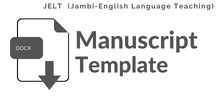JUNIOR HIGH SCHOOL STUDENTS’ LEARNING STYLES IN LEARNING ENGLISH
DOI:
https://doi.org/10.22437/jelt.v8i1.32207Abstract
The success of English teaching and learning process depends on many things. One of them is the compatibility of the teaching method, teaching and learning process, and the characteristics of the students. One of the students’ characteristics is learning styles when learning English. This study aims at investigating learning styles of students at two state junior high schools in Jambi city. This study employed descriptive and quantitative research design, using a questionnaire as the instrument. The result of the study shows that of the sixth learning styles, the learning styles mostly used by the students are kinesthetic, tactile, and learning in group. Besides, the students appear to exhibit multiple minor learning styles.
Downloads
References
Ardi, Havid. (2007). Profil gaya belajar bahasa Inggris siswa SMA Negeri 7 Kota Padang. Jurnal Bahasa Sastra dan Seni,1.
Dunn, R., and S. Griggs. 1988. Learning styles: Quiet revolution in American secondaryschools. Reston, Va.: National Association of Secondary School Principals.
Dunn, R and Dunn,K (1979). Learning Styles/ Teaching styles: Should They…. Can they… be matched? Educational Leadership
Dunn, R. & Dunn, K. (1978). Teaching Students Through Their Individual Learning Styles: A Practical Approach. Reston. Virginia.RestonPublishing.
Drummond, C. (1998). Composing functions to speed up reinforcement learning in a changing world,In Proceedings of the Tenth European Conference on Machine Learning.
Ebadi, Saman., & Goodarzi, Ahmad. (2023). Exploring perceptual learning-style preferences of English language non-gainers in computerized dynamic reading assessment. Reading Psychology, 44(1).
Faisal, R. (2019). Influence of personality and learning styles in English language achievement. Open Journal of Social Sciences, 7, 304-324. doi: 10.4236/jss.2019.78022.
Fleming, N.D. & Mills, C. (1992). Not Another Inventory, Rather a Catalyst for Reflection. To Improve the Academy: A journal of Educational Development, 11(1).
Gay. R. L (1992). Educational Research for Analysis and Application, Fourth Edition. New York: Macmillan
Kartigeyan, K dan Nirmala, K (2013), Learning Style Preference of English Language Learnars.Educationia Confab.
Keefe J.W. (1979). Learning style: An overview. In J.W. Keefe (Ed.). Student Learning Styles: Diagnosing And Prescribing Programs. Reston, VA: National Association of Secondary School Principals.
Kolb, D., (1984). Experiential learning: Experience as the source of Learning and Development. New Jersey: Prentice Hall.
Obralic, N., & Akbarov, A. (2012). Students’ preference on perceptual learning style. Acta DidacticaNapocensia, 2 (3).
Reid, J. (1995). LearningStyles in the EFL/ESL Classroom. Heinle & Heinle publisher
Willing K. (1988). Learning Styles In Adult Migrant Education. Adelaide, Australia: National Curriculum Resource Centre.
Downloads
Published
Issue
Section
License
Copyright (c) 2024 Hustarna, Masbirorotni

This work is licensed under a Creative Commons Attribution-ShareAlike 4.0 International License.







